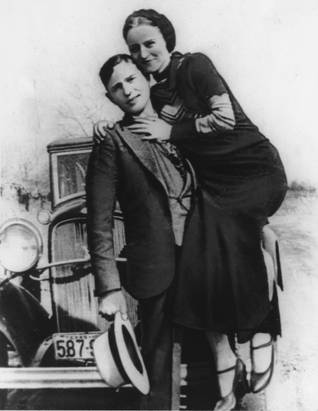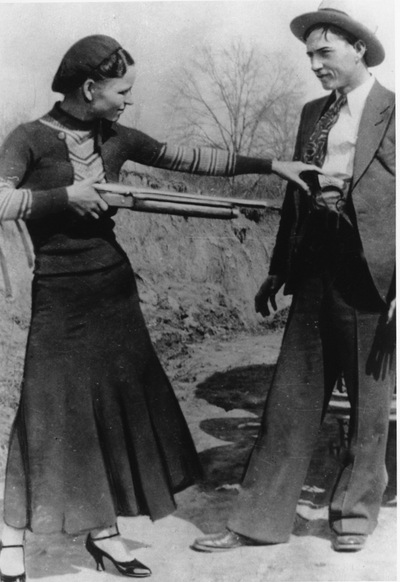
AP File
Bandits Bonnie Parker and Clyde Barrow are seen in an undated photo.
Monday, May 26, 2014 | 2 a.m.
GIBSLAND, La. — Seven miles down the road, two crooks died a long time ago.
For most other criminals, that could have been the end of the story. But Bonnie and Clyde live on. In the imagination of the public, Hollywood, haunted descendants and here on Main Street in this tiny town about an hour east of Shreveport, the legacy of their two-year crime spree endures 80 years after their bloody deaths on May 23, 1934.
It is here in this northern Louisiana town of 979 that the son of Ted Hinton, a Dallas County deputy who was in the posse that killed Bonnie Parker and Clyde Barrow, has set up shop to tell the story of how the couple and their gang lived and died. His Bonnie & Clyde Ambush Museum shows how the two robbed banks and killed people, loved each other and died young.
Boots Hinton, the son, was born not long before his father helped kill the two outlaws on State Highway 154, which remains remote today. He said there are two big reasons people latch on to Bonnie and Clyde.
“One, it’s a love story that would put Romeo and Juliet to shame,” he said. “The other is guts and bullets — the blood.”
Hinton’s museum shows how Barrow and Parker went from an early life in the slums of West Dallas to become national icons, folk heroes, villains and hunted criminals. The Dallas-area kids were thieves who lived on the lam. They wore fancy clothes. They grew their myth as common people who robbed the big banks during the Great Depression.
Bonnie and Clyde met at a house party in 1930. She was about 20 and he was a year older. But then Clyde spent a two-year stint in Eastham Prison Farm, where inmates were often beaten. There, Hinton says, he became a hardened criminal. Ralph Fults, a fellow prisoner who later became a member of Barrow’s gang, reportedly said he saw Clyde go “from a schoolboy to a rattlesnake.” Clyde reportedly killed another inmate who had sexually abused him there.
When he got out, he was constantly harassed by police because he was an ex-con, said Clyde’s nephew, Buddy Barrow Williams of Sunnyvale.
“Clyde just told his mother, ‘Mom, they’re not going to let me be free. I’ll see them in hell.’ ”
Bonnie, who quickly fell in love with the boyish-looking Clyde, just as quickly adapted to his way of life.
“Their crime spree had very little to do with money,” said John Neal Phillips, a historian who wrote two books about the couple. “That wasn’t the point. For Bonnie, the point was being with Clyde. And for Clyde, the point was revenge.”
•••
Clyde developed a fetish for guns and cars. He drove like a stunt car driver and could “outgrit” anyone, Williams said.
And he was stylish for a poor boy — “you had to have a suit if you were going to run with his gang,” Hinton said.
Clyde started a crime gang made up of family members and friends. He became a thief and a killer. Some 13 slayings are attributed to his gang, most of them officers.
But many Americans didn’t see the couple as bad actors. Instead, Phillips said, many romanticized their actions, imagining them as sticking it to the big banks and the law during the Great Depression. The fact that they were young and did whatever they wanted appealed to people, he said.
Even today, they have defenders. Boots Hinton said Clyde was only personally responsible for about six of the killings. And he would only shoot if someone fired at him first, he said. Then they had a war on their hands, he said.
Hinton said his father and another lawman, Bob Alcorn, were assigned by Dallas County Sheriff Smoot Schmid — who came to office in 1933 — to capture Bonnie and Clyde. They got close a few times, only to learn later that the gang had narrowly evaded them.
Ted Hinton knew Barrow’s family growing up in Dallas. He told his son that Barrow wasn’t a bad person, Hinton said. Barrow just strayed and chose to live by the sword. Hinton said his father believed for a long time that he could persuade Barrow to give up peacefully. But after Clyde escaped from a gunfight involving the elder Hinton, he realized he would have to kill him, Boots Hinton said.
Bonnie was different. She isn’t believed to have killed anyone, and lawmen didn’t want to kill her. Even Clyde supposedly wanted her to leave him so she would be safe.
“She was an empirical romantic,” Hinton said. “A poet. Sang like a nightingale. Had aspirations of being an actress on Broadway.”
Her biggest flaw? “A bad taste in men,” Hinton said.
•••
She knew that she might die with Clyde, but that was OK with her; she reportedly told concerned family members that life wouldn’t be worth living without him.
So on that fateful day in May 1934, Bonnie and Clyde grabbed two sandwiches to go from the restaurant that would later become Hinton’s Ambush Museum.
Lawmen lay in wait for the couple for hours. They spotted the car and identified the driver as Clyde. Ted Hinton wrote in a firsthand account that Barrow appeared to be reaching for his gun before they fired.
Police shelled the car, a Ford V-8, with about 150 shots. After so many gunfights with Barrow, they weren’t taking any chances.
After police stopped shooting, Hinton went up to the door. He told his son that Bonnie tumbled out of the side.
“He told me, ‘Son, she was breathing when I caught her, but she wasn’t by the time I bundled her up to put her in the car,’ ” Boots Hinton said.
Ted Hinton brought an 8 mm camera for the occasion and filmed officers removing a cache of weapons from the car with the bodies still inside. The footage plays at his son’s museum, which he has run for almost 10 years. Newsreel footage also waxes on about how it was up to Clyde’s relatives to live a normal life and restore their reputation.
Hinton decided after the death that he would help them to do so.
“Ted appointed himself protector of the families,” Boots Hinton said of his father. “One of the deputies asked him about that at the sheriff’s office when he got back, and said, ‘Ted, why’d you do a fool thing like that?’ And he said, ‘Well, somebody has to protect the lambs from the wolves.’ ”
For years, the families tried to get beyond the legacies. The mother of Bonnie Parker’s niece, Bonnie Ray Parker, changed her daughter’s name to Rhea Leen Linder to avoid unwanted attention.
“It was fresh back then,” said Linder, 79, who lives in Dallas and works in retail. “Now it wouldn’t make a bit of difference.”
Over time, the public’s perception of the notorious couple has become more positive. She said people claim to want to be a relative of Bonnie, which she said she will never understand.
Buddy Barrow Williams, the stepson of Clyde’s brother L.C. Barrow, said his family was constantly harassed by lawmen. One even came to their home shortly after they moved, decades later, to tell them he knew who they were and that he was watching them.
Williams never understood the story as a child. He said he often heard his family talking about Clyde and his brother Buck, who was a member of the gang until his death in 1933, but never got the full story until he got older. He just thought they were alive and lived out of state.
And after the 1967 movie “Bonnie and Clyde” starring Warren Beatty and Faye Dunaway in the title roles, the saga and Bonnie and Clyde’s relatives gained even more attention every anniversary.
“People started looking for us like we were some kind of freak side show,” Williams said.
Hinton, however, says the movie isn’t an accurate portrayal.
“There is as much difference between the movie and reality as there is dark and light,” Hinton said.
The story has spawned countless books — including one by Ted Hinton — movies and TV shows. An A&E miniseries on the pair aired in December. The Dallas Historical Society has offered Bonnie and Clyde tours.
The site of their death in Louisiana stands in quiet contrast to all the hubbub about their lives. The woods are still piney and empty. Few cars drive by. Two small markers — one tombstonelike marker that denotes the spot where they died and one dedicated to the posse that killed them — are there, covered in signatures from visitors.
The two are buried in separate cemeteries in Dallas about nine miles apart. The car they died in is now in a Nevada casino.
And decades later, the families are still trying to move on from all the attention. Williams said he is asked about Bonnie and Clyde after every major anniversary of their deaths, but Linder said she is likely done with anniversary celebrations this year. Doctors have told Hinton, now 80 and battling myriad health problems, that he works more than he should at the museum.
But the story will live on — perhaps because there will probably never be another Bonnie and Clyde, Hinton said. At least not on that scale.
“Nowadays with the advent of communications and all that, they’d probably last 20, 30 minutes,” he said.
Even back then, in the days before the Internet and instant messaging, they seemed to have been lucky, said Phillips, the historian.
“I’m actually surprised they lived as long as they did,” he said.


Join the Discussion:
Check this out for a full explanation of our conversion to the LiveFyre commenting system and instructions on how to sign up for an account.
Full comments policy